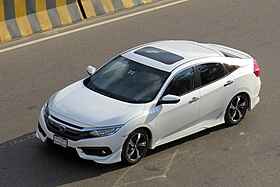The Honda Civic is a line of small cars manufactured by Honda. Originally a subcompact, the Civic has gone through several generational changes, becoming both larger and more upmarket and moving into the compact car segment. EPA guidelines for vehicle size class stipulate a car having combined passenger and cargo room of 110 to 119.9 cubic feet (3,110 to 3,400 L) is considered a mid-size car, and as such the tenth generation Civic sedan is technically a small-end mid-size car, although it still competes in the compact class.[1] The Civic coupe is still considered a compact car. The Civic currently falls between the Honda Fit and Honda Accord.
The first Civic was introduced in July 1972 as a two-door model,[2] followed by a three-door hatchback that September. With an 1169 cc transverse engine and front-wheel drive like the British Mini, the car provided good interior space despite overall small dimensions.[3]Initially gaining a reputation for being fuel-efficient, reliable, and environmentally friendly, later iterations have become known for performance and sportiness, especially the Civic Type R, Civic VTi, Civic GTi and Civic SiR/Si.[4][5]
The Civic has been repeatedly rebadged for international markets, and served as the basis for the Honda CR-X, the Honda CR-X del Sol, the Honda Concerto, the first generation Honda Prelude, the Honda Civic Shuttle (later to become the Honda Orthia), and the Honda CR-V.
In Japan, as customers increasingly shifted to minivans and compact cars like Honda Fit, production of non-hybrid Civic ended in August 2010 when it no longer complied with Japanese Government dimension regulations in the width category.[6] However, the Civic was reintroduced into the Japanese market with the launch of the tenth generation model in 2017.[7]

ftv-news.com Great article, I really appreciate your thought process and having it explained properly, thank you
ReplyDeletehttps://www.ftv-news.com/